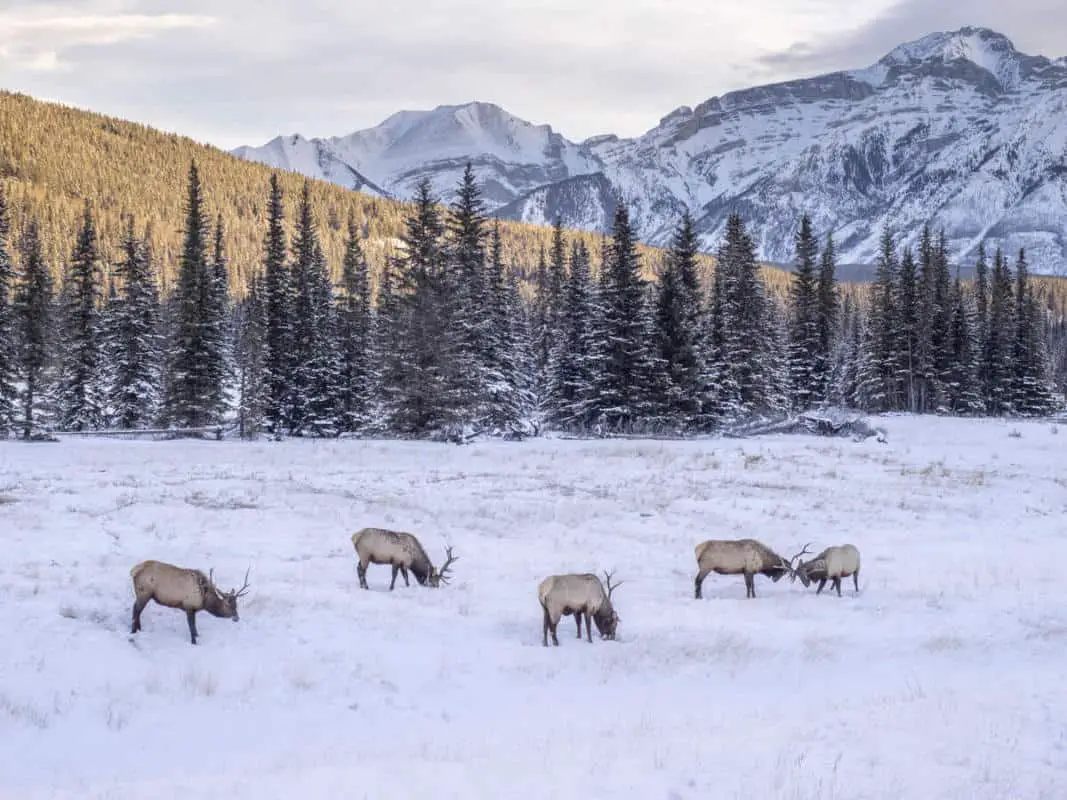Banff National Park is home to a diverse range of wildlife. In winter, some animals hibernate, and many others remain active and can be spotted throughout the park. In fact, winter is an excellent time to view wildlife in Banff, as the animals are often more visible against the snowy landscape.
Sure, Banff and Lake Louise are known for their abundant wildlife in the summer, but that doesn’t mean you can’t see animals in the winter. There are plenty of opportunities; when you see one, they stand out against the white background.
Let’s take a look at what animals you might see and what the winter wildlife looks like in Banff!
What Are the Best Locations to See Wildlife in Banff in Winter?
Banff National Park is home to diverse wildlife, and winter is an excellent time to observe these animals in their natural habitat. Here are some of the best locations to see wildlife in Banff in winter:
Vermilion Lakes
Vermilion Lakes is a popular spot for wildlife viewing in Banff. During winter, the lakes freeze over, providing a perfect habitat for animals such as coyotes, wolves, and elk. You can observe these animals from the shore.
Johnston Canyon Trail
Johnston Canyon Trail is another popular spot for winter wildlife viewing in Banff. The trail is on a boardwalk, making it accessible for the whole family. The trail is covered in snow and ice during winter, creating a beautiful winter wonderland. You may spot animals such as moose, elk, and bighorn sheep along the way.
Lake Louise
Lake Louise is a must-visit location in Banff and a great place to see wildlife in winter. The lake is surrounded by mountains and forests, providing a perfect habitat for animals such as elk, moose, and wolves. You can observe these animals from the shore.
Bow Valley Parkway
The Bow Valley Parkway (Highway 1A) is a scenic drive parallel to the Trans-Canada Highway. During winter, the parkway is not nearly as busy as in the summer, making it an excellent spot for winter wildlife viewing. You may spot animals such as elk, moose, and – if you’re (very) lucky – wolves along the way.
Banff Gondola
The Banff Gondola is a popular attraction in Banff and provides an excellent opportunity for winter wildlife viewing. At the top of the gondola, you can observe animals such as bighorn sheep, elk, and mountain goats in their natural habitat.
What Is the Best Time of Day to See Wildlife in Banff in Winter?
If you want to increase your chances of seeing wildlife, you obviously want to know the best time of day to look for them. Well, that’s early morning or late afternoon.
During these times, animals are most active, especially when searching for food. You may also have better luck spotting wildlife on sunny days, as they tend to be more active when the weather is mild.
I guess you know that wildlife is unpredictable, so there is no guarantee that you will see any animals during your visit. However, visiting during the best time of day and keeping a sharp eye out can increase your chances of spotting some critters.
Banff’s Winter Wildlife
Here are some of the characteristics of the most common animals you may encounter during your winter visit to Banff National Park:
Bears in Banff in Winter
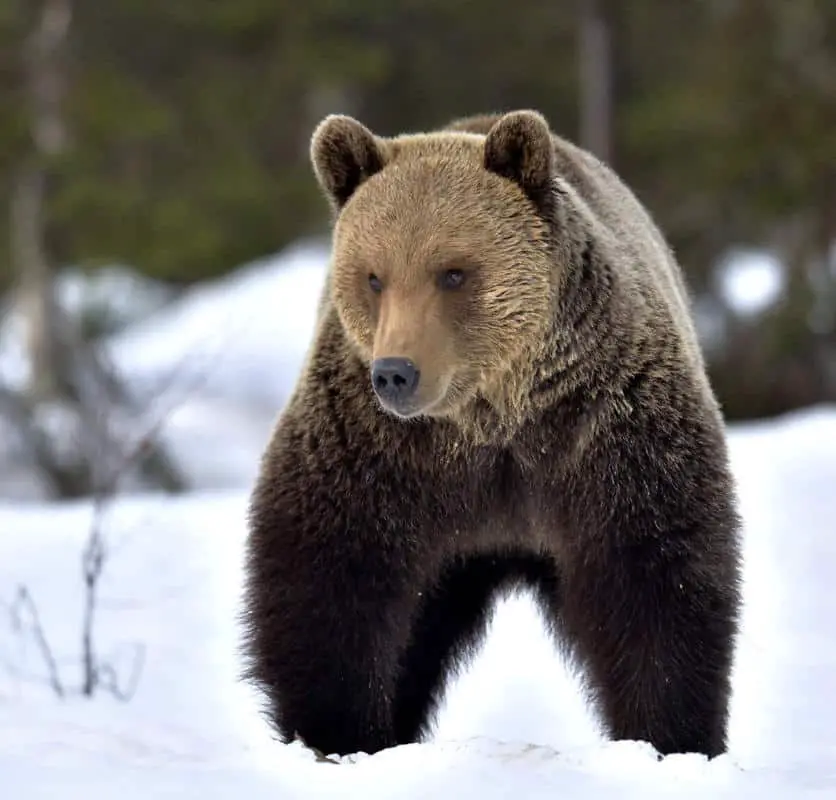
Grizzly bears and black bears are undoubtedly the most iconic animals in Banff National Park. During winter, they are typically in hibernation and not visible to visitors. However, if you are lucky, you may glimpse a grizzly or black bear emerging from its den in early spring.
Banff National Park is home to both black bears and grizzly bears. During winter, bears go into hibernation and can be found in dens. It is important to note that bears may wake up from hibernation if they are disturbed. So, staying on designated trails and following wildlife viewing guidelines is crucial.
Bears are omnivores and feed on various foods, including berries, roots, and small mammals.
ALSO READ: Where to spot bears in Banff
Wolves in Banff in Winter
Wolves are one of Banff National Park’s most elusive and fascinating animals. They often travel in packs and can be seen hunting for prey. While they are not typically a threat to humans, always keep a safe distance and avoid approaching them.
While they can be difficult to spot, winter is an excellent time to look for them, as their tracks are often visible in the snow. You may even hear them howling in the distance if you’re lucky.
Moose in Banff in Winter
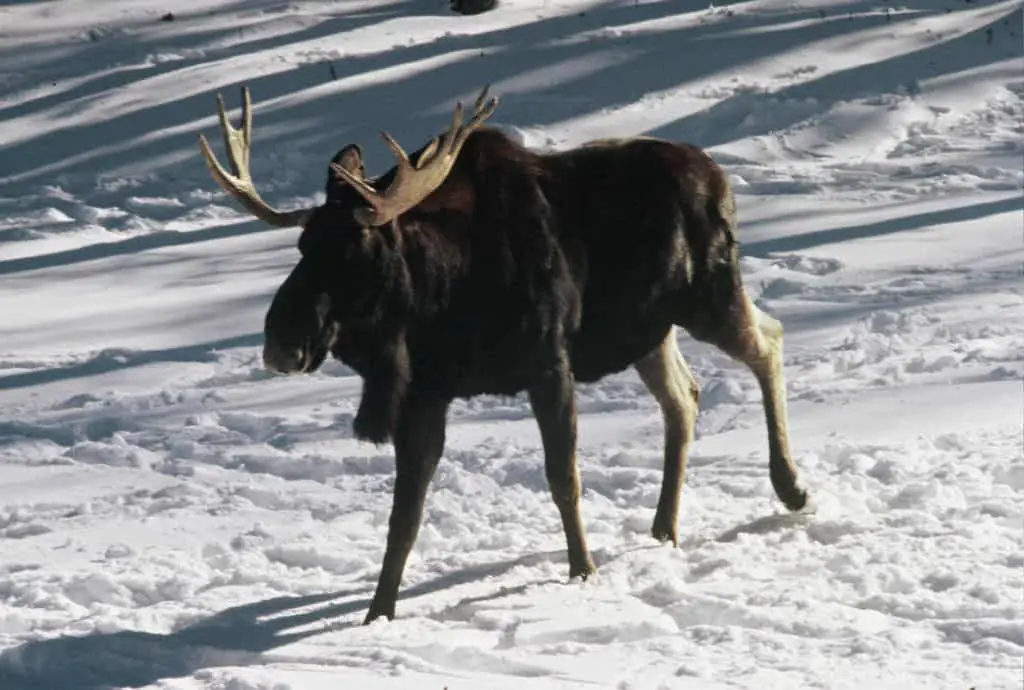
Moose are the largest members of the deer family, and they are a rare sight in Banff National Park. They are often seen near water sources such as rivers and lakes. Know that moose can be unpredictable and should be observed from a safe distance. Keep an eye out for them in areas with dense vegetation, such as around the shores of Vermilion Lakes.
Bison in Banff in Winter
Bison are very rare in Banff National Park but can occasionally be spotted during winter. They typically move to lower elevations for food and can often be seen grazing in meadows.
Elk in Banff in Winter
Elk, also known as wapiti, are one of the largest species of the deer family and one of the most commonly seen large mammals in Banff. They can be easily identified by their majestic appearance and large antlers, which can grow up to four feet in length.
During the winter, they can often be found in the park’s lower elevations, grazing in open fields or near the edges of forests, feeding on grasses and shrubs. You may even see them wandering through the town of Banff itself!
They are most active during the early morning and late afternoon.
ALSO READ: Elk in Banff National Park
Deer in Banff in Winter
Deer are a common sight in Banff National Park during the winter months. They are often seen grazing in meadows and can be easily spotted due to their distinctive white tails. It is important to keep a safe distance and avoid approaching them.
Bighorn Sheep in Banff in Winter
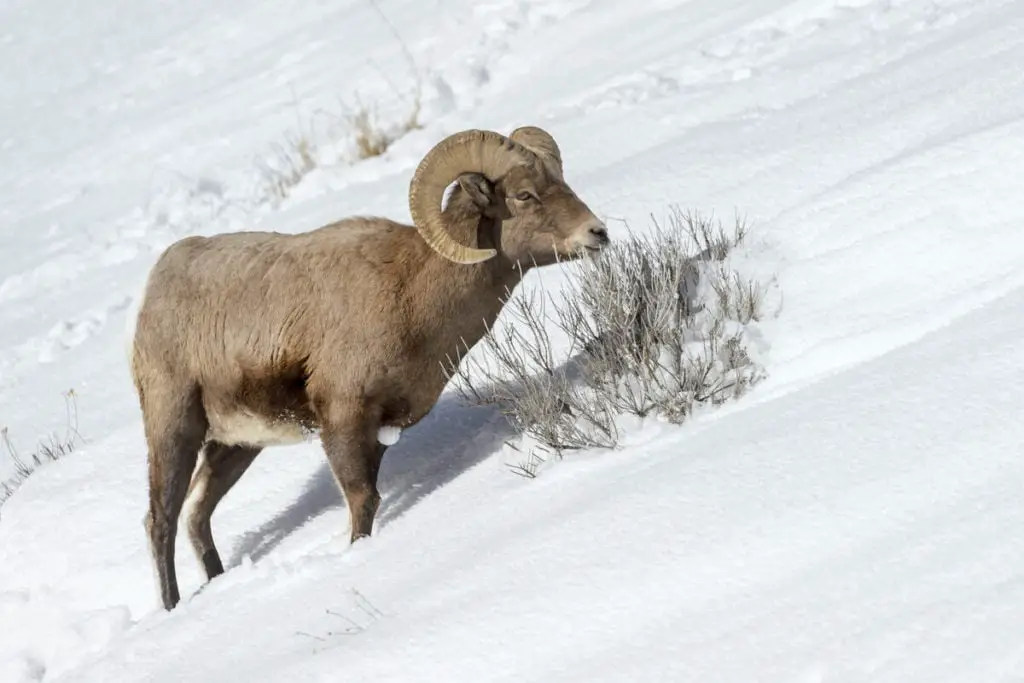
Bighorn sheep are another common sight in Banff during the winter. They are well adapted to life in the mountains, and you can often see them scaling steep cliffs and rocky outcroppings.
They are known for their impressive curved horns, weighing up to 30 pounds. Bighorn sheep are usually found in rocky areas, where they can easily climb steep cliffs, such as along the slopes of Mount Norquay. They tend to graze on grasses and shrubs and are most active during the day.
Mountain Goats in Banff in Winter
Mountain goats are a unique species well-adapted to Banff National Park’s rugged terrain. Their thick white fur helps them blend in with the snow and sharp hooves that allow them to climb steep cliffs. Mountain goats are herbivores and feed on lichens, grasses, and shrubs. They are most active during the day.
Other Wildlife in Banff in Winter
In addition to these animals, Banff National Park is also home to various other wildlife, including wolves, coyotes, lynx, and more than 250 species of birds. Keep your eyes peeled and your camera ready, as you never know what you might see during your visit to Banff in the winter.
What Precautions to Take for Winter Wildlife Viewing in Banff?
While viewing wildlife can be an incredible experience, taking precautions is essential to ensure your and the animals’ safety. Here are some tips for safely viewing wildlife in Banff during the winter:
Keep Your Distance
Maintain a safe distance from wildlife at all times. This is especially true during the winter, when animals are more likely to be stressed and aggressive due to the harsh conditions.
Parks Canada recommends staying at least 30 meters (100 ft) away from bears and at least 100 meters (328 ft) away from wolves and cougars.
Use Bear Spray
Bear spray is an essential tool for anyone venturing into bear country. Always carry bear spray with you and know how to use it properly. You should spray Bear spray directly at the bear’s face if it charges or attacks.
Test your bear spray before heading out into the wilderness to ensure it’s working correctly.
You can also use it on other animals if a dangerous situation arises.
ALSO READ: How to use bear spray
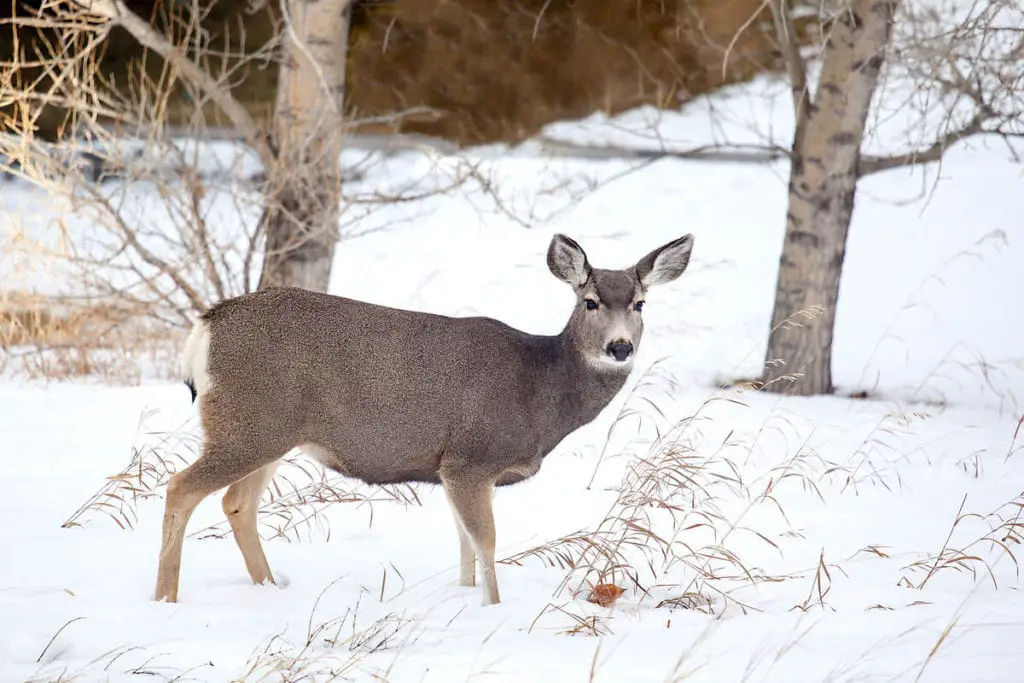
Stay on Designated Trails
Staying on designated trails is important for your safety and the safety of the animals. Venturing off-trail can disturb wildlife and damage their habitat. Also, avoid areas frequented by wildlife, such as animal carcasses or dens.
Keep Your Pets on a Leash
If you’re traveling with pets, make sure to keep them on a leash at all times. Pets can disturb wildlife and put themselves in danger if they get too close to animals. Also, clean up after your pets to prevent the spread of disease.
Travel in Groups
When hiking or snowshoeing, travel in groups of four or more. This makes noise and helps prevent surprising wildlife, reducing the risk of a dangerous encounter.
Store Food Properly
When camping or staying in backcountry cabins, store your food in bear-resistant containers or hang it from a tree at least 4 meters (13 ft) above the ground and 1 meter (3 ft) away from the tree trunk.
Respect Wildlife Closures
Wildlife closures may be put in place to protect animals during sensitive times such as mating or birthing season. Please respect these closures and stay out of designated areas, as it protects the animals and their habitats. Violating them can result in fines.
Report Wildlife Sightings
If you encounter wildlife during your visit to Banff, report the sighting to Banff Dispatch at +1 403 – 762 1470. This information helps Parks Canada monitor wildlife activity and take necessary precautions to protect visitors and animals.
Photographing Winter Wildlife
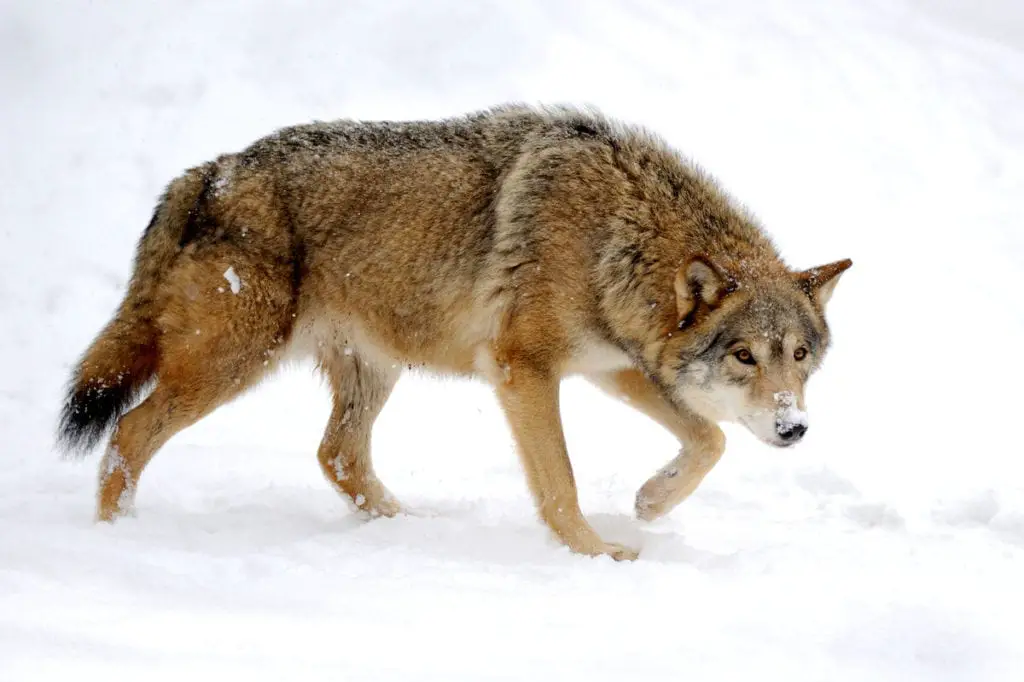
If you’re interested in photographing winter wildlife, Banff is a great place to do it. Here are a few tips to help you get the best shots:
Be Prepared
Before photographing winter wildlife, ensure you’re prepared for the conditions. Dress in warm layers, wear waterproof boots and bring hand warmers and extra batteries for your camera. Bringing a tripod or monopod to stabilize your shots is also a good idea.
Know Where to Look
Some of the best places to see winter wildlife in Banff are along the Bow Valley Parkway and the Icefields Parkway. Look for areas where there is open water, as this is where animals like to gather. Also, watch for tracks in the snow, which can help you locate animals.
Be Patient
Photographing winter wildlife can be a waiting game, so be patient. Set up your equipment and wait for the animals to come to you. Keep your eyes and ears open, and be ready to capture the moment when it happens.
Capture the Moment
When photographing winter wildlife, try to capture the animals in their natural habitat. Look for interesting angles and compositions, and use the surrounding landscape to add context to your shots.
Experiment with different shutter speeds and apertures to get the best exposure. Don’t be afraid to take multiple images to ensure you get the perfect one.
Adaptations of Wildlife in Winter
In winter, the Canadian Rockies can be a hostile environment for wildlife. The animals that live in Banff National Park have adapted to survive in this harsh environment. Here are a few examples of the adaptations that wildlife have developed to survive in winter:
Thick Fur
Many animals in Banff have thick fur coats that help them stay warm in the winter. For example, the lynx has a thick coat of fur that keeps it warm in temperatures as low as -40°C (-40°F). Similarly, the bighorn sheep has a thick coat of fur that helps it stay warm during winter.
Hibernation
Some animals, such as the ground squirrel and the bear, hibernate during the winter to conserve energy. During hibernation, the animal’s body temperature drops, and its metabolism slows. This allows the animal to survive on stored fat reserves until the spring, when food becomes more plentiful.
Migration
Other animals, such as elk and deer, migrate to lower elevations in the winter to find food and avoid deep snow. This behavior allows them to survive where food is scarce during winter.
Food Storage
Some animals, such as the red squirrel, store food in summer and fall (“caching”) to eat in winter. These animals have evolved to have a keen sense of smell and excellent memory to help them find the food they have stored.
Fur Color Change
Snowshoe hares have adapted to the winter environment by changing the color of their fur from brown to white. This allows them to blend in with the snow and avoid predators. They also have large feet with fur on the soles that act like snowshoes, allowing them to move quickly on top of the snow.
Impact of Climate Change on Winter Wildlife
Winter is challenging for wildlife, and climate change makes it even more difficult for them to survive. The changing weather patterns, including warmer temperatures and less snowfall, affect the availability of food, habitat, and water sources for wildlife in Banff.
Food Shortages
With warmer temperatures, some animals, such as marmots and ground squirrels, emerge from hibernation earlier in the year. This means they need to find food earlier, but the plants they rely on for sustenance may not have started growing.
This can lead to food shortages and malnutrition, which can have serious consequences for their survival.
Other animals, such as deer and elk, rely on vegetation that grows in the summer and fall to store fat reserves for the winter.
However, with less snow on the ground, these animals may have more difficulty finding food and may have to travel further. This can increase stress and weaken immune systems, making them more vulnerable to disease and predation.
Habitat Loss
Climate change is also affecting the habitats of many species in Banff. As temperatures warm, some animals may be forced to move to higher elevations to find suitable habitats.
However, if they cannot find a suitable habitat, they may be forced to move to areas with less food and water, which can be detrimental to their survival.
Additionally, changes in precipitation patterns can lead to changes in the distribution and abundance of plant species, which can have cascading effects on the entire ecosystem.
For example, if a plant species that provides essential food or habitat for a particular animal is less abundant, it can lead to a decline in the population of that animal.
Water Sources
Climate change is affecting the availability of water sources for wildlife in Banff. With less snowfall, less water may be available for animals to drink. This can lead to dehydration, which can have serious consequences for their health and survival.
Changes in precipitation patterns can also lead to changes in the timing and location of water sources. For example, if a stream or river dries up earlier in the year, it may not be available as a water source for animals that rely on it later in the year.

